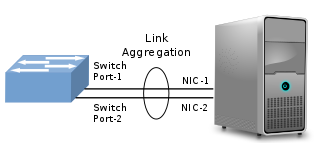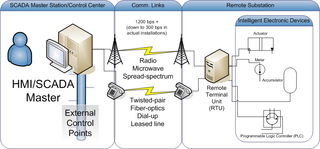Related Research Articles

Synchronous Optical Networking (SONET) and Synchronous Digital Hierarchy (SDH) are standardized protocols that transfer multiple digital bit streams synchronously over optical fiber using lasers or highly coherent light from light-emitting diodes (LEDs). At low transmission rates data can also be transferred via an electrical interface. The method was developed to replace the plesiochronous digital hierarchy (PDH) system for transporting large amounts of telephone calls and data traffic over the same fiber without the problems of synchronization.

An inverse multiplexer allows a data stream to be broken into multiple lower data rate communication links. An inverse multiplexer differs from a demultiplexer because the multiple output streams from the former stay inter-related, whereas those from the latter are unrelated. An inverse multiplexer is the opposite of a multiplexer in that it divides one high-speed link into multiple low-speed links, whereas a multiplexer combines multiple low-speed links into one high-speed link.

In telecommunications and computer networking, multiplexing is a method by which multiple analog or digital signals are combined into one signal over a shared medium. The aim is to share a scarce resource – a physical transmission medium. For example, in telecommunications, several telephone calls may be carried using one wire. Multiplexing originated in telegraphy in the 1870s, and is now widely applied in communications. In telephony, George Owen Squier is credited with the development of telephone carrier multiplexing in 1910.

MIL-STD-188 is a series of U.S. military standards relating to telecommunications.
A virtual local area network (VLAN) is any broadcast domain that is partitioned and isolated in a computer network at the data link layer. In this context, virtual refers to a physical object recreated and altered by additional logic, within the local area network. VLANs work by applying tags to network frames and handling these tags in networking systems – creating the appearance and functionality of network traffic that is physically on a single network but acts as if it is split between separate networks. In this way, VLANs can keep network applications separate despite being connected to the same physical network, and without requiring multiple sets of cabling and networking devices to be deployed.
In the IEEE 802 reference model of computer networking, the logical link control (LLC) data communication protocol layer is the upper sublayer of the data link layer of the seven-layer OSI model. The LLC sublayer acts as an interface between the media access control (MAC) sublayer and the network layer.
Distributed Interactive Simulation (DIS) is an IEEE standard for conducting real-time platform-level wargaming across multiple host computers and is used worldwide, especially by military organizations but also by other agencies such as those involved in space exploration and medicine.
In computer networking, a heterogeneous network is a network connecting computers and other devices where the operating systems and protocols have significant differences. For example, local area networks (LANs) that connect Microsoft Windows and Linux based personal computers with Apple Macintosh computers are heterogeneous.

In computer networking, link aggregation is the combining of multiple network connections in parallel by any of several methods. Link aggregation increases total throughput beyond what a single connection could sustain, and provides redundancy where all but one of the physical links may fail without losing connectivity. A link aggregation group (LAG) is the combined collection of physical ports.

Distributed Network Protocol 3 (DNP3) is a set of communications protocols used between components in process automation systems. Its main use is in utilities such as electric and water companies. Usage in other industries is not common. It was developed for communications between various types of data acquisition and control equipment. It plays a crucial role in SCADA systems, where it is used by SCADA Master Stations, Remote Terminal Units (RTUs), and Intelligent Electronic Devices (IEDs). It is primarily used for communications between a master station and RTUs or IEDs. ICCP, the Inter-Control Center Communications Protocol, is used for inter-master station communications. Competing standards include the older Modbus protocol and the newer IEC 61850 protocol.
IEEE 802.11n-2009, or 802.11n, is a wireless-networking standard that uses multiple antennas to increase data rates. The Wi-Fi Alliance has also retroactively labelled the technology for the standard as Wi-Fi 4. It standardized support for multiple-input multiple-output, frame aggregation, and security improvements, among other features, and can be used in the 2.4 GHz or 5 GHz frequency bands.
IEEE 1901 is a standard for high-speed communication devices via electric power lines, often called broadband over power lines (BPL). The standard uses transmission frequencies below 100 MHz. This standard is usable by all classes of BPL devices, including BPL devices used for the connection to Internet access services as well as BPL devices used within buildings for local area networks, smart energy applications, transportation platforms (vehicle), and other data distribution applications.

A computer network is a set of computers sharing resources located on or provided by network nodes. Computers use common communication protocols over digital interconnections to communicate with each other. These interconnections are made up of telecommunication network technologies based on physically wired, optical, and wireless radio-frequency methods that may be arranged in a variety of network topologies.
PME Aggregation Function (PAF) is a computer networking mechanism defined in Clause 61 of the IEEE 802.3 standard, which allows one or more Physical Medium Entities (PMEs) to be combined to form a single logical Ethernet link.

Multi-link trunking (MLT) is a link aggregation technology developed at Nortel in 1999. It allows grouping several physical Ethernet links into one logical Ethernet link to provide fault-tolerance and high-speed links between routers, switches, and servers.
IEEE 802.11a-1999 or 802.11a was an amendment to the IEEE 802.11 wireless local network specifications that defined requirements for an orthogonal frequency-division multiplexing (OFDM) communication system. It was originally designed to support wireless communication in the unlicensed national information infrastructure (U-NII) bands as regulated in the United States by the Code of Federal Regulations, Title 47, Section 15.407.

In radio, multiple-input and multiple-output (MIMO) is a method for multiplying the capacity of a radio link using multiple transmission and receiving antennas to exploit multipath propagation. MIMO has become an essential element of wireless communication standards including IEEE 802.11n, IEEE 802.11ac, HSPA+ (3G), WiMAX, and Long Term Evolution (LTE). More recently, MIMO has been applied to power-line communication for three-wire installations as part of the ITU G.hn standard and of the HomePlug AV2 specification.
A multi-chassis link aggregation group is a type of link aggregation group (LAG) with constituent ports that terminate on separate chassis, primarily for the purpose of providing redundancy in the event one of the chassis fails. The IEEE 802.1AX-2008 industry standard for link aggregation does not mention MC-LAG, but does not preclude it. Its implementation varies by vendor; notably, the protocol existing between the chassis is proprietary.
A radio access technology (RAT) is the underlying physical connection method for a radio communication network. Many modern mobile phones support several RATs in one device such as Bluetooth, Wi-Fi, and GSM, UMTS, LTE or 5G NR.
FlexE, short for Flexible Ethernet, is a communications protocol published by the Optical Internetworking Forum (OIF).
References
- ↑ Fredette, P.H. (1994). "The past, present, and future of inverse multiplexing". IEEE Communications Magazine. IEEE Communications Society. 32 (4): 42–46. doi:10.1109/35.275334. S2CID 8022507. Abstract.